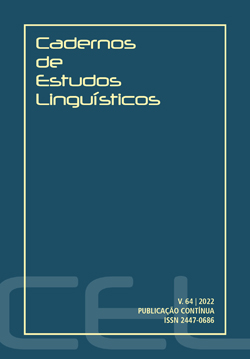Abstract
The aim of this study is to examine the phonological structure of lexical blends produced by slips of the tongue, which are blends resulting from a deviation during linguistic processing, such as mosquilongo (pernilongo [a type of mosquito] + mosquito). In order to investigate their phonological structure, 40 blends collected from natural speech were analyzed in terms of their segmental features, word stress and syllable structure. The analysis shows that while the production of speech error blends respected the phonological restrictions of Brazilian Portuguese, as reported in the literature on neological blends, the fact that the structures of the original items had similarities and were maintained suggests that the production of blends is facilitated when there is a structural similarity between the elements in question.
References
ALVES, I. M. Neologismo: criação lexical. São Paulo: Editora Ática, 1990.
ARAUJO, G. Morfologia não-concatenativa em português: os portmeanteux. Cadernos de Estudos Linguísticos, Campinas. v. 39, p. 5-21, 2000.
BISOL, L. A sílaba e seus constituintes. In: Neves, Maria Helena de Moura (Org.). Gramática do Português culto falado: novos estudos. Campinas: Editora da Unicamp, v.7, p. 701-742, 1999.
CÂMARA JR, J. Estrutura da Língua Portuguesa. Rio de Janeiro: Editora Vozes, 1970.
CLEMENTS, G. Place of articulation in consonants and vowels: an unified theory. Working papers of the Cornell phonetics laboratory, n. 5, p. 77-123, 1991.
BOOMER, D. S.; LAVER, J. D. M. Slips of the tongue. In: Ed. FROMKIN, V. A. (Org.). Speech Errors as Linguistic Evidence. The Hague: Mouton, 1973.
ESPADARO, M. Os lapsos de fala em Português Brasileiro sob a perspectiva da morfologia distribuída. 2018. 183f. (Dissertação de Mestrado em Linguística) – Faculdade de Filosofia, Letras e Ciências Humanas, USP, São Paulo, 2018.
FROMKIN, V. A. The nonanomalous nature of anomalous utterances. Language. v. 47, p. 27-52, 1971.
GOLDSMITH, John. Autossegmental Phonology. Tese de Doutorado – Massachusetts Institute of Technology, Cambridge - Massachusetts, 1976.
GONÇALVES, C. A. Blends lexicais em português: não-concatenatividade e correspondência. Veredas, Juiz de Fora, v. 7, n. 1 e 2, p.149-167, 2003.
ILIOVITZ, E. R. Uma análise prosódica dos lapsos da língua. 2001.142 f. (Dissertação de Mestrado em Linguística) - Instituto de Estudos da Linguagem, Unicamp, Campinas, 2001.
ILIOVITZ, E. R. Fronteiras Linguísticas dos Lapsos da Língua. Letras & Letras. v. 23, n. 2, jul./dez., p. 81-110, 2007.
LEVELT, W. J.M. Speaking: From Intention to Articulation. Cambridge, MA: MIT Press, 1989.
NETO, N.A. Outras palavras: as palavras-valise entre revisões e sistematizações. Revista Tabuleiro de Letras, PPGEL, v. 10, n. 02, p. 46-64, 2016.
NÓBREGA, V.; MINUSSI, R. 2014. O tratamento da morfologia não-concatenativa pela morfologia distribuída: o caso dos blends fonológicos. Revista Letras, n. 91, p. 158-177, 2015.
PFAU, R. Grammar as processor. A Distributed Morphology account of spontaneous speech errors. Amsterdam: John Benjamins, 2009.
SÂNDALO, M. F. Morfologia. In.: MUSSALIN, F. & BENTES, A. C. (Eds.). Introdução à Lingüística. São Paulo: Cortez, v. 1, p. 45-67, 2001.
SANDMANN, A. J. Morfologia Lexical. São Paulo: Contexto, 1990.
SELKIRK, E. The syllable. In: Hulst, Harry & Smith, Norval (Eds.) The Structure of Phonological Representations. Dordrecht: Foris, p. 337-383, 1982.
VIGÁRIO, Marina. Prosodic structure between the prosodic word and the phonological phrase: Recursive nodes or an independent domain?. The Linguistic Review, v. 27, n. 4, p. 485-530, 2010.
WARKER, J.; DELL, G. Speech errors reflect newly learned phonotactic constraints. Journal of Experimental Psychology: Learning Memory and Cognition, v. 32, n. 2, p. 387-398, 2006.

This work is licensed under a Creative Commons Attribution-NonCommercial 4.0 International License.
Copyright (c) 2022 Cadernos de Estudos Linguísticos


